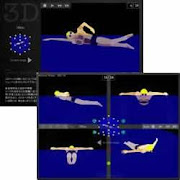
Around the pool deck, it is rumored that open water swimmers have bad turns. While that may be true, turns are defined differently by open water swimming community.
Great pool swimmers know how to quickly get in and out of the walls. World-class swimmers gain momentum as they streamline off the wall with maximum velocity. The incredible power of Michael Phelps and the beautiful grace of Natalie Coughlin off the walls are truly something to watch.
Do open water swimmers really have bad turns? Pool turns, maybe. What is considred a good open water turn? How are these turns executed?
There are 5 major distinctions.
1. TIME TO EXECUTE
A pool swimmer focuses on a good turn once he or she reaches the backstroke flags. In and out of the walls in a flash, the world’s best swimmers tuck tightly and propel themselves with powerful underwater kicks.
In contrast, the world’s best open water swimmer are thinking about their turns at least 200 meters before they hit the turn buoys. They are either pushing the pace to gain optimal positioning or moving around their opponents so they will not be squeezed as the pack swims around the buoy.
While pool swimmers only take seconds to traverse between the backstroke flags and wall, the “turn” time of an open water swimmer can be 2-3 minutes, a strategist's dream.
2. SOLO vs. PACK
In a controlled environment with an 8-foot lane and multiple lane lines separating them from the nearest competitor, pool swimmers focus entirely on their own technique in and out of the walls where every tenth counts.
In stark contrast, open water swimmers must always be cognizant of their competitors. They must protect their head, arms and body with aggressive or inexperienced swimmers all around them. One errant elbow, one kick of a heel or a tangled set of arms can quickly lead to a sudden loss of 2-5 meters.
While a pool swimmer can lose precious of tenths of a second to a competitor, an open water swimmer can lose several meters or be injured at the turns. If this physical contact forces the swimmer out of the racing pack, they may never be able to regain their position in a fast-moving group. Tough turns equal tough luck.
3. 180º vs. 90º
A pool swimmer swims in one direction, turns and swims back in the opposite direction. They practice and master these 180º turns every day in practice.
In contrast, open water swimmers face a number of types of turns throughout their career. Some races require turns going in the clockwise direction, which are generally harder for a right-handed swimmer. Other races require turns going in the counter-clockwise direction, which are generally harder for left-handed swimmers. Some races have different types of turns even within the same race. Many races require a combination of turns in both directions.
Some races have 180º turns where the swimmers make U-turns around the turn buoys. Some races have 90º turns where heels and legs can hit swimmers following behind. Some races have 45º turns that require different techniques. Some races in windy or wavy conditions, especially when the buoys are anchored in deep water, have MOVING turn buoys.
Like individual medley swimmers who master four different types of turns in the pool, open water swimmers must master innumerable different types of turns that come only with years of practice.
4. SINGULARITY vs. MULTIPLICITY
The turn efficiency of pool swimmers is entirely their own responsibility. In and out of the walls, the pool swimmer is an individual swimming alone.
In contrast, when a large pack of open water swimmers enters the turn area, everyone except the lead swimmers get squeezed. For those swimmers in the back of the pack, the loss relative to the leaders becomes multiplied. The leader can extend his or her lead to a greater extent over the fifth-placed swimmer than over the second-placed swimmer.
This is one reason why the Russian open water swimmers, who are considered to be master tacticians, always position themselves no further than third or fourth in a major race. If an open water swimmer falls behind to positions beyond fifth, the loss around the turn buoys is generally multiplied.
5. PRACTICE MAKES PERFECT
Pool swimmers practice their turns every workout. Swimmers can be confident that their turns will be the same in a pool in Los Angeles and a pool in London. The backstroke flag, the black cross on wall and the vertical concrete surface are the same in every pool.
In contrast, open water swimmers usually only get to practice turns at the race course within a couple of days before the race. In many local races, the turn buoys are anchored on the race day morning.
Also, each turn must be navigated with different sightings and, occasionally, with or against different currents.
Some races have large orange marine buoys; other races have small buoys that are partly hidden behind swells, the sun's glare or escort boats within the swimmer's line of sight.
SUMMARY
Open water swimmers may have less efficient flip turns than their pool counterparts, but they still have a lot to think about when navigating in and out of their own turns in the open water.
Photo by Dr. Jim Miller at the 2007 World Swimming Championships in Melbourne, Australia.
Copyright © 2008 by World Open Water Swimming Association




















No comments:
Post a Comment